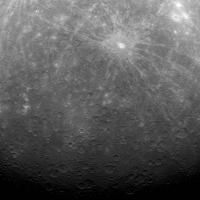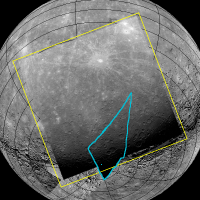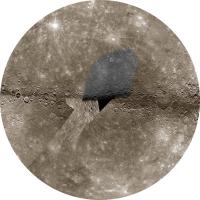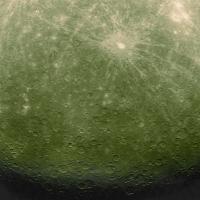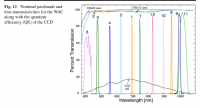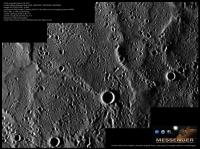Printable Version of Topic
Click here to view this topic in its original format
Unmanned Spaceflight.com _ Messenger _ MESSENGER ARRIVES
Posted by: Astro0 Mar 17 2011, 05:29 AM
Less than 20 hours now until the MESSENGER spacecraft fires its engine to enter orbit at Mercury.
http://mfile.akamai.com/7111/live/reflector:22179.asx?bkup=22194 March 17th – broadcast starts at 0030 UTC.
Follow the progress: http://messenger.jhuapl.edu/mer_orbit.html.
There will be commentary on the mission, real-time coverage of the maneuver, animation of what the spacecraft is doing, a view of the carrier’s Doppler as they receive it, and live video from MESSENGER Mission Operations.
Remember that the Canberra DSN is providing two-way communication with MESSENGER ![]()
We'll be using both DSS43 (70-metre) and DSS34 (34-metre) antennas.
Good luck to the team at Johns Hopkins University Applied Physics Laboratory (APL).
Posted by: nprev Mar 17 2011, 06:19 AM
Aim your dishes well, Astro0, and may no passing birds cause the loss of a single bit! ![]()
Very exciting time. "Firsts" just never get old. Best of luck to the entire Messenger team, including of course the FAR too-often unappreciated people who keep the DSN up & running!
Posted by: Explorer1 Mar 17 2011, 06:39 AM
Mercury is a disk already in the 'where is MESSENGER now' view. It's getting exciting already...
Posted by: dmuller Mar 17 2011, 12:15 PM
7.9 billion kilometers just to get there. That makes it one of the longest distances flown by a spacecraft:
(http://www.dmuller.net/spaceflight/realstats.php?stats=flown).
Anyway, my standard realtime simulation is now updated for MOI:
http://www.dmuller.net/messenger
Posted by: Sunspot Mar 17 2011, 02:25 PM
I can't get "Mars" Orbit Insertion (MOI) out of my head, rather than Mercury Orbit Insertion (MOI) !!!!
Posted by: Decepticon Mar 17 2011, 07:24 PM
Is there a way to listen to MOI via my cell phone?
I would love to watch but I'm working at that time.
Audio would be great!
Any help?
Posted by: akuo Mar 17 2011, 07:55 PM
Is it so that there is no following of the MOI on any Nasa-TV channels?
Answering my own post: looks like that the Nasa-TV schedule has been updated and Messenger will be followed on Nasa-TV from 19:55 ESST onwards:
7:55 p.m. - MESSENGER: Mercury Orbit Insertion Coverage from APL - APL/HQ (ALL Channels)
Posted by: Gsnorgathon Mar 17 2011, 10:24 PM
Since this mission's run by JHUAPL and not JPL, do we still need to get our dry-roasted peanuts for MOI?
Posted by: B Bernatchez Mar 17 2011, 10:35 PM
(http://www.dmuller.net/spaceflight/realstats.php?stats=flown).
Anyway, my standard realtime simulation is now updated for MOI:
http://www.dmuller.net/messenger
Shouldn't the last item on that list read "Start of first mission extension"?
Posted by: djellison Mar 17 2011, 11:36 PM
It's in Eyes on the Solar System as well - complete with the change of attitude, and the engine burn ![]() http://go.usa.gov/4u1
http://go.usa.gov/4u1
(shortcut works great in Firefox/Safari/IE - but there's a bug that we need to sort out about Chrome)
Posted by: volcanopele Mar 17 2011, 11:37 PM
Good to know! I tried getting MESSENGER to work in Celestia with the spice kernels available from the PDS, but it keeps balking ![]()
Posted by: MahFL Mar 18 2011, 12:30 AM
Hello everyone.
Pretty exciting !
Posted by: ZLD Mar 18 2011, 12:31 AM
Yes and Mercury is getting quite large on the screen.
Posted by: MarkG Mar 18 2011, 12:43 AM
I like the Irish music in the background of some of the on-line presentations. Nice!
Being part of this exploration history never gets old...
Posted by: Explorer1 Mar 18 2011, 12:56 AM
Start of burn confirmed, looking at Doppler.
Posted by: Bjorn Jonsson Mar 18 2011, 12:57 AM
"Thruster firing, everything looking just perfect"
Posted by: Astro0 Mar 18 2011, 01:00 AM
Gotta say that I'm enjoying the JHU/APL broadcast. Very slick. Live audience adds a nice element. ![]()
Posted by: DFinfrock Mar 18 2011, 01:04 AM
Emily has a great Twitter feed going, if you can't view the Webcast. Follow her at @elakdalla.
ADMIN: http://twitter.com/elakdawalla
Posted by: Hungry4info Mar 18 2011, 01:06 AM
MESSENGER is in orbit of Mercury now.
Posted by: Hungry4info Mar 18 2011, 01:09 AM
End of main burn, tweaking now.
Edit: Lots of clapping, handshakes, looks like everything went just perfectly! Waiting on data from spacecraft to confirm.
Edit2: High rate telemetry is being received. We know now the burn did last as long as expected.
Edit3: Official confirmation of successful MOI burn. Made the target to within 0.5-sigma.
Posted by: belleraphon1 Mar 18 2011, 01:59 AM
unmanned spacecraft in orbit.. firsts..
1966 Luna 10 Moon
1971 Mariner 9 Mars
1975 Venera 8 Venus Venera 9 was the first Venus orbiter. Venera 8 was a lander with a flyby bus.
1995 Galileo Jupiter
2004 Cassini Saturn
2011 Messenger Mercury
Lived through all of them.... HOW SWEET IT IS!
i ate peanuts
Congrats team!
Posted by: pjam Mar 18 2011, 01:59 AM
Messenger is confirmed to be in orbit around Mercury -Hooray!! ![]()
...Now the serious visit begins!
-pjam
Posted by: belleraphon1 Mar 18 2011, 02:14 AM
And... of course...
Sputnik 1957 Earth... the shot that started it all... yeah Earth is a planet.
Glorious 54 years... I was 4 that year.
Craig
Posted by: tasp Mar 18 2011, 03:12 AM
Was super busy all day today, and just now came to this thread, and with a rising sense of anticipation, read all the posts.
Whew! And attaboys and 'ham sammiches' to everyone!
I did go out the other night to see Mercury and Jupiter after sunset, and was hoping all was well.
Posted by: NMRguy Mar 18 2011, 03:54 AM
At long last, MESSENGER enters orbit! Congrats to the team and let the science begin (following check out, of course)!
Posted by: Paolo Mar 18 2011, 06:22 AM
you forgot poor Eros...
Posted by: Explorer1 Mar 18 2011, 06:27 AM
And Itokawa! (if it counts as 'orbiting' at all....)
Posted by: Paolo Mar 18 2011, 07:19 AM
Itokawa was too small. Hayabusa didn't do much orbiting, only station keeping in solar orbit
Posted by: CAP-Team Mar 18 2011, 07:45 AM
Congrats! Great to hear that it worked!
@Volcanopele you can find good spice kernels on the NAIF FTP site in the PDS folder for use in Celestia, including the main mission period.
Posted by: Stu Mar 18 2011, 08:17 AM
Fantastic news! And if you haven't seen it already, Emily has made an absolutely gorgeous pic for her blog, showing Mercury's size compared to other familiar bodies in the solar system...
http://www.planetary.org/blog/article/00002965
Posted by: craigmcg Mar 18 2011, 08:57 AM
Nice article in the NY Times
http://www.nytimes.com/aponline/2011/03/17/science/AP-US-SCI-Mercury.html?_r=1&partner=rss&emc=rss
Posted by: ngunn Mar 18 2011, 09:36 AM
Indeed, a very nice comparison. But we already know of two other bodies in that size range, namely Pluto and Eris, making a total of 10.
Posted by: Stu Mar 18 2011, 09:57 AM
True, but we haven't got very good images of those to use, tho.
Posted by: belleraphon1 Mar 18 2011, 11:38 AM
unmanned spacecraft in orbit...
how did I miss the worldlets????? Eros and possibly Itokawa.... must be my age... and the beer.
Thanks for the corrections folks.
The Eyes on the Solar System site had a terrific simulation.... really felt like I was riding along as I listened to the webcast.
Terrific experience...
Kudos all .....
Craig
Posted by: brellis Mar 18 2011, 01:07 PM
Emily's survey is great! I felt proud to recognize each orb, like a bunch of old friends. ![]()
Posted by: ElkGroveDan Mar 18 2011, 01:58 PM
I used to have friends like that; remote, lonely, frigid, two-faced, endlessly going in circles, still showing the obvious scars that impacted them long ago. Sure there was always at least one hot one, but she'd usually be prone to eruptions. Since then I found UMSF and a whole new universe of friends.
Posted by: Stu Mar 18 2011, 01:59 PM
![]()
![]()
Posted by: machi Mar 18 2011, 02:11 PM
Congratulation to the MESSENGER team! ![]()
Posted by: Stu Mar 18 2011, 02:43 PM
VERY proud that the MESSENGER team used a new poem I wrote for them, marking MOI...
http://messenger.jhuapl.edu/mer_orbit.html
(bottom right)
![]()
Posted by: gndonald Mar 18 2011, 03:54 PM
Congratulations to NASA!
I'm eagerly awaiting the first light photo from orbit...
Posted by: elakdawalla Mar 18 2011, 04:32 PM
http://www.planetary.org/blog/article/00002965
I'm glad you liked that; I'm pleased with how it turned out, though of course it looks good mostly because of Ted's excellent processing work. It's wonderful what matching phase angles and lighting directions will do to improve the feel of a montage. I spent half an hour discussing that image with my girls' babysitter last night -- a fun conversation
As Stu said, we don't have images of those! --but in the text and caption I did make an error about how these were all the things in the solar system between 2000 and 6000 km across -- should've stuck with 2500-6000 and I'd've been correct; or just left Triton off and left it at 3000-6000. I have a massive cheat sheet above my desk that I use to do quick size comparisons, but I don't have the KBOs on there yet because I'm still working on hunting down the best estimates of their sizes. I have got to finish that project.
Me too
Posted by: tedstryk Mar 18 2011, 04:59 PM
It isn't an error - all are in that range.
Posted by: nprev Mar 18 2011, 06:14 PM
Belated congrats after a long night of work to the MESSENGER team for their own many, many long nights of work that resulted in not only a spectacular success but a truly historical achievement. ![]()
Posted by: Drkskywxlt Mar 18 2011, 07:10 PM
I was in the studio audience last night and I want to give kudos to APL for putting on a very entertaining and informative show. Pretty amazing that by July we'll have spacecraft orbiting 8 solar system bodies (Sun, Mercury, Venus, Earth, Moon, Mars, Vesta and Saturn). Too bad MESSENGER probably won't be around in 2016 when Juno arrives at Jupiter to make it 9!
Posted by: nprev Mar 18 2011, 07:21 PM
A challenge indeed, considering Ted's great skill at reprocessing data from older missions!
Okay, I'll take a shot, from left to right (the last one is a gimmie, though):
Messenger, Clementine, Cassini, Galileo, Galileo, Voyager 1, Cassini, Voyager 2.
<braces for humiliation>...
(And congratulations to Stu for his terrific poem posted on Messenger's most special day....
Posted by: elakdawalla Mar 18 2011, 07:49 PM
You got half right, Nick! ![]()
Posted by: tedstryk Mar 18 2011, 08:57 PM
The moon looks like an oddly colored earth-based view, Titan is clearly from Cassini. I will ignore the others, since that really wouldn't be fair.
Posted by: SFJCody Mar 18 2011, 09:13 PM
The Mercury view is Mariner 10 - you can see the Caloris basin on the terminator.
Posted by: Oersted Mar 18 2011, 11:13 PM
Congrats to the Messenger team and their new in-house poet, Stu!
Posted by: brellis Mar 19 2011, 01:57 AM
"The challenge for us uber-geeks is to know just from looking at them which spacecraft was responsible for each image. "
share?!
Posted by: elakdawalla Mar 19 2011, 04:23 AM
Mercury: Mariner 10; Moon, an Earth-based photographer (sorry, that was a trick one); the Galileans all from Galileo; Titan from Cassini; Triton from Voyager 2.
See http://planetimages.blogspot.com/2009/09/four-galilean-moons-from-galileo.html
and
http://www.lpod.org/coppermine/displayimage.php?album=37&pos=97
Posted by: eoincampbell Mar 19 2011, 05:17 AM
Successfully named orbs, but camera names - not...hopefully,a few more years of UMSF, PS and AmateurSpaceImages etc., should take good care of that!
Congrats to the MESSENGER team, looking forward to the images.
Posted by: JohnVV Mar 19 2011, 10:05 AM
a few days old
I have been ill
same here there is some "odd" thing going on
i has been a few months but right now celestia thinks it is out by mars
right now i am thinkint to just skip the first 3 trips around and use only the CURRENT and forward
then fix it .
- quote from "CAP-Team"
for those here that do not know that address
ftp://naif.jpl.nasa.gov/pub/naif/pds/data/
Posted by: Greg Hullender Mar 19 2011, 04:17 PM
The Messenger site has updated the "Where is Messenger" page with seven new views, including the Messenger ground track. Check it out.
http://messenger.jhuapl.edu/whereis/index.php
--Greg
Posted by: J.J. Mar 19 2011, 05:32 PM
Though I'm a little late to the thread, I'd like to congratulate everyone involved on a job well-done. ![]()
Posted by: Julius Mar 20 2011, 09:31 AM
![]() congrats to the messenger team..a job well done!
congrats to the messenger team..a job well done!
Posted by: tanjent Mar 20 2011, 04:09 PM
I can't load Greg's "where is Messenger" link. Maybe the site is taking a well-deserved weekend's rest along with the personnel?
In the temporary absence of photographic evidence of Messenger's arrival, we'll have to stave off our hunger by consuming a week's worth of sims.
Will try again Monday.
Posted by: brellis Mar 20 2011, 05:02 PM
My eyes are getting thirsty for pics!! ![]()
Posted by: Explorer1 Mar 20 2011, 07:34 PM
The link is fine on my end.
Posted by: tedstryk Mar 20 2011, 08:10 PM
It isn't going to take pictures until March 29, so don't hold your breath.
Posted by: Greg Hullender Mar 21 2011, 04:13 AM
Seems to be working now: http://messenger.jhuapl.edu/whereis/index.php
Perhaps they do site maintenance on Sundays.
--Greg
Posted by: hendric Mar 21 2011, 06:41 PM
Ah, but May 2014 will have Rosetta orbiting Comet 67P/Churyumov-Gerasimenko (can we start calling it C-G now?
Posted by: tedstryk Mar 22 2011, 09:59 AM
Nope, and you have to say it fast five times every time you mention it.
Posted by: Stu Mar 25 2011, 08:52 PM
Really wanted to get this pic to mark MESSENGER's arrival, so tonight I hiked up to the castle even with my knackered knee...!
Four days before MESSENGER starts photographing Mercury - Mercury seen from Kendal:
http://twitpic.com/4d8896
Posted by: bkellysky Mar 25 2011, 10:51 PM
Nice shot!
It's good to get a wide-angle view (like yours) before getting the close-up (MESSENGER's).
P.S., if anyone hasn't seen Mercury in the evening sky - low in the west 30 minutes after sunset - do it now as Mercury is fading fast (from Earth's point of view).
bob
http://bkellysky.wordpress.com/
Posted by: Stu Mar 25 2011, 11:00 PM
Thanks ![]() Even wider angle shot...
Even wider angle shot...
http://twitpic.com/4d88na
(Mercury's a bit hard to see - you need to enlarge the image by putting your cursor at the pic's top right to bring up an "enlarge" optionm then you'll see Mercury between the tower and tree. You might need to squint, but it's there.
Honest. ![]()
Posted by: bkellysky Mar 25 2011, 11:44 PM
*Sigh*
That's wonderful!
My photos were taken from a high school football field's bleachers.
Your shot was worth the climb!
Posted by: Holder of the Two Leashes Mar 26 2011, 08:17 PM
Everything seems to be going okay so far.
http://www.spaceflightnow.com/news/n1103/23messenger/
"Engineers switched on six of MESSENGER's seven science instruments Wednesday to start commissioning and calibrations ..."
Posted by: Greg Hullender Mar 29 2011, 04:17 AM
First pics tomorrow. Will anyone attend the press conference?
http://messenger.jhuapl.edu/news_room/details.php?id=164
Posted by: Astro0 Mar 29 2011, 04:28 AM
It's a 'teleconference' so any media only need to phone-in.
Plus anyone can listen in via the http://www.nasa.gov/news/media/newsaudio/index.html Stream.
Posted by: nprev Mar 29 2011, 04:32 AM
IIRC, some of the first images will be of a previously unobserved region near the North Pole?
Posted by: elakdawalla Mar 29 2011, 04:35 AM
I *think* Louise said south pole. It's gonna be one of the poles though. I'll be phoning in for the telecon. If anybody thinks of a great question to ask, post here or Tweet me ![]()
Posted by: nprev Mar 29 2011, 04:40 AM
Well, not a 'great' question, but what is the expected resolution of the first images, and what other instruments will be acquiring data?
Posted by: ugordan Mar 29 2011, 07:51 AM
South pole it is.
http://messenger.jhuapl.edu/gallery/sciencePhotos/image.php?gallery_id=2&image_id=429
Posted by: Anders Mar 29 2011, 09:42 AM
I am curious about the orbital period of the MESSENGER spacecraft. Is it exactly 12 hours? If so, how was it chosen?
Posted by: MahFL Mar 29 2011, 01:13 PM
"The MESSENGER team designed the orbit to optimize the scientific yield of the mission and data transfer to Earth, while addressing thermal environment concerns.".
MESSENGER spends most of the time away from the surface to transmit data back to earth, and not to overheat due to reflected heat.
Posted by: Holder of the Two Leashes Mar 29 2011, 01:59 PM
"Finnegan told Spaceflight Now the spacecraft is in an orbit with a closest approach 128.5 miles above Mercury's surface and a high point of 9,482.7 miles. The orbit is inclined 82.5 degrees to Mercury's equator and it takes MESSENGER more than 12 hours to complete one circuit of the planet, according to Doppler tracking data."
So it's more than twelve hours, but they don't say how much more.
Posted by: Anders Mar 29 2011, 04:30 PM
Thank You,
I got the impression that it was exactly 12 hours. That would have been an interesting trade-off.
Posted by: Phil Stooke Mar 29 2011, 04:41 PM
Twelve hours period, with a major data downlink every other orbit, would simplify operations by having the same DSN coverage each day.
From the mission design page:
"After MESSENGER arrives in the primary science orbit, small forces, such solar radiation pressure – the force exerted by sunlight - slowly change the spacecraft's orbit. Although these small forces have little effect on MESSENGER's 12-hour orbit period, they can increase the spacecraft's minimum altitude, orbit inclination, and latitude of the surface point below MESSENGER's minimum altitude. Left uncorrected, the increase in the spacecraft's minimum altitude would prevent satisfactory completion of certain science goals.
To keep this minimum altitude below 500 kilometers (310 miles), propulsive maneuvers must occur in pairs once every Mercury year - every 88 days. The first maneuver in each pair increases the orbit period to 12 hours, 15 minutes by speeding up the spacecraft at its closest distance from Mercury. Two-and-a-half orbits later a maneuver at the farthest distance from Mercury slows the spacecraft just enough to adjust the orbit period back to 12 hours and return the minimum altitude to 200 kilometers (124 miles). Because the sunshade must protect the main part of the spacecraft from direct sunlight during propulsive maneuvers, the timing of these maneuvers is limited to a few days when Mercury is near the same point in its orbit as it was at Mercury orbit insertion."
So the current period might not be exactly 12 hours but that's immaterial, the intention is to keep adjusting it to stay around 12 hours all the time (and the correct altitude etc.).
Phil
Posted by: ugordan Mar 29 2011, 05:20 PM
Those orbital parameters translate to 12 hours 4 minutes period if I got it right. You can never tell with "miles"...
Posted by: Hungry4info Mar 29 2011, 08:21 PM
From http://www.nasa.gov/mission_pages/messenger/multimedia/mercury_orbit_image.html
Posted by: charborob Mar 29 2011, 08:26 PM
Messenger took 363 images after that first one. More images to be posted tomorrow at 2 pm EDT.
Posted by: Bjorn Jonsson Mar 29 2011, 08:50 PM
The image is centered at approximately 15°E and 55°S. This is a major improvement over earlier imaging coverage in this area and of course there are going to be narrow angle images as well. At a quick glance nothing that looks especially interesting. There are fairly strong contrast/brightness variations associated with some of the craters. Many scarps. And there is an interesting looking crater plus some associated features at (280,255).
Posted by: ugordan Mar 29 2011, 09:00 PM
Looks good, nice to see the WAC behaving as if nothing happened. ![]()
Posted by: volcanopele Mar 29 2011, 09:23 PM
Here is the image laid on top of the released footprint map. The blue outline is the area that was blank on the map to this point. The blue dot is the south pole.
Posted by: Anders Mar 29 2011, 09:29 PM
Interesting point about DSN, I didn't thought about that.
Posted by: Phil Stooke Mar 29 2011, 09:39 PM
Very rough fit of the image to a colorized version of the pre-orbit mosaic, south polar view. (only adding the bit which improves on the previous coverage)
Phil
Posted by: brellis Mar 30 2011, 03:56 AM
I read an article saying thrusters have to be fired every few months to keep MESSENGER from floating into a higher orbit by the Sun's gravity. I don't get that, since it's in a polar orbit.
Oh, wait -- the Sun is ALWAYS tugging on things, and at the proximity of Mercury, it gets taken into account throughout the orbit, on a scale similar to instances where the ISS fires thrusters to stay at altitude versus miniscule atmospheric drag. Okay, I get that.
When it doesn't have any fuel left, will it get sucked into the Sun?
LOL! The mission science is just beginning, I'm already wondering what's going to happen to our intrepid spacecraft when it runs out of fuel! ![]()
Posted by: eoincampbell Mar 30 2011, 04:04 AM
It really is astounding science, all hail MESSENGER team,
cue: heavy orchestral sounds for MESSENGER images ![]()
Posted by: Hungry4info Mar 30 2011, 04:44 AM
The plan is for an impact on Mercury. But hypothetically, if they were to refrain from adjusting the orbit, and if MESSENGER left Mercury's hill sphere, it would orbit the sun.
Posted by: HughFromAlice Mar 30 2011, 05:01 AM
What a great achievement!!!
First historic pic from orbit - and since I always love to experiment and bring out as much detail as possible in photos just for my own interest - I did a false colour (+ a few other things) version during lunch which seemed worth posting. So here it is!! Haven't been here for a while but good to see everyone's passion and skills again :-)
Hi res 6 mb!! version at https://picasaweb.google.com/102206315340567528232/Mercury?authkey=Gv1sRgCKTrsYXQypO19gE#5589730326334840018
Posted by: Explorer1 Mar 30 2011, 05:46 PM
There's a link to the teleconference on this page now:
http://www.nasa.gov/news/media/newsaudio/index.html
Posted by: Hungry4info Mar 30 2011, 06:00 PM
Several new images have appeared http://messenger.jhuapl.edu/gallery/sciencePhotos/view.php?gallery_id=2&page=1&bydate=2011-03.
As for questions: where are the raw images posted?
Posted by: elakdawalla Mar 30 2011, 06:32 PM
No raw images for this mission, but their first delivery to the PDS will be just 6 months after orbit insertion, probably including 2 months worth of data.
Posted by: nprev Mar 31 2011, 05:05 AM
First color image released:
http://messenger.jhuapl.edu/gallery/sciencePhotos/pics/first_color.coreg.rgb.png
Hopefully this is an approximation of 'natural'; if so, we're in for a real treat! ![]()
Posted by: ZLD Mar 31 2011, 06:45 AM
I've actually been wondering, are the filters on the WAC as narrow as the graph below portrays? If so, how close to 'natural' is actually possible for the images?
Posted by: djellison Mar 31 2011, 01:33 PM
I see no reason why the chart would be wrong. The aim is not to take 'natural' color photographs. The aim is to do science. Much like with MER and other spacecraft, you take those science filters and approximate a true color view using algorithms.
Posted by: Drkskywxlt Mar 31 2011, 01:40 PM
I believe it's enhanced with the IR filters to bring out the blue/yellow shades. So, I don't believe it's what your eye would see if you were in MESSENGER's position.
Still a nice pic though!
Posted by: tedstryk Mar 31 2011, 01:42 PM
It is what you might see if your eyes were properly designed to study the surface composition of Mercury. ![]()
Posted by: Phil Stooke Mar 31 2011, 04:49 PM
New pic!
Phil
http://messenger.jhuapl.edu/gallery/sciencePhotos/image.php?gallery_id=2&image_id=442
Posted by: john_s Mar 31 2011, 06:44 PM
Because Mercury's visible spectrum is pretty bland, I expect that using images from these narrowband filters to determine true color shouldn't be much harder than it would be for broadband filters.
John
Posted by: nprev Apr 1 2011, 02:02 AM
@ Phil: There's a lot going on in that image. Is that an ancient lava 'riverbed'? Also, what's with the linear streaking in that vicinity.
Oh, this is gonna be a fun mission!!!! ![]()
Posted by: stevesliva Apr 1 2011, 02:10 AM
There would appear to be a lot of secondary impacts. I should look it up in Google Mercury and see if that makes sense...
Posted by: Explorer1 Apr 1 2011, 07:28 AM
Check the Wikipedia front page (April 1st).
Nice tribute in the news section.
Posted by: volcanopele Apr 1 2011, 09:16 AM
have I said how much I love April Fool's Day.
Posted by: Phil Stooke Apr 1 2011, 01:56 PM
"Is that an ancient lava 'riverbed'?"
No! It's a secondary crater chain - look at the so-called Rima Stadius I on the Moon for a comparison (it's not called that any more) - just NE of Copernicus.
Phil
Posted by: Phil Stooke Apr 1 2011, 04:18 PM
More pictures up...
Phil
Posted by: zeBeamer Apr 1 2011, 08:57 PM
new and unexpected images from MESSENGER arrived today !
http://messenger.jhuapl.edu/gallery/sciencePhotos/image.php?gallery_id=2&image_id=448
Erwan
Posted by: tanjent Apr 1 2011, 09:33 PM
Dang, I still can't access jhuapl and a number of other U.S. sites from here in Taiwan. Does anyone else have a similar problem? The Cassini site is also inaccessible to me most of the time recently. I complained to my ISP and they actually blamed it on the Japan earthquake - but tracert indicates the problem is somewhere in the U.S. I thought the Internet was designed to be robust in the face of point blockages whatever the cause. Anyway I hope there will be plenty of secondary renderings springing up on this thread and elsewhere, before the "oohs" and "aahs" drive me nuts! Thanks Hugh, for your offering in 93 - spectacular.
Posted by: stevesliva Apr 1 2011, 10:00 PM
You can always try a proxy. Sometimes intermediate DNS caching screws you. For awhile I couldn't access my college's domain from my employer's network. Sending a few emails went nowhere on that one, too.
Posted by: nprev Apr 2 2011, 01:37 AM
http://messenger.jhuapl.edu/gallery/sciencePhotos/image.php?gallery_id=2&image_id=448
Posted by: Ron Hobbs Apr 2 2011, 04:54 PM
SuhWEET!
Posted by: maschnitz Apr 4 2011, 05:52 AM
This may be an odd question. Maybe I've misunderstood the science here. But is MESSENGER expected to markedly improved the ephemerides of Mercury and other solar system bodies?
Something I've been interested in (very casually! not a scientist!) is the accuracy of our knowledge of the planet's positions, and how folks use them to make statements about orbital stability and solar system masses and stuff like that. (eg. http://syrte.obspm.fr/journees2010/powerpoint/folkner.pdf)
Is this supposed to be no improvement, a minor improvement, or a major improvement? Are there any specific results expected or hoped for?
Posted by: Phil Stooke Apr 4 2011, 02:26 PM
Ranging and Doppler might make some improvements to the orbit data, and the rotation axis orientation, though maybe not much improvement over what radar has already given us. Other bodies? - I can't see that. The questions you are interested in are probably addressed most thoroughly with radar, at least out to Saturn's orbit. Goldstone and Arecibo routinely do radar ranging and doppler for solar system targets.
Phil
(PS - new pics up again!)
Posted by: Astro0 Apr 4 2011, 11:37 PM
In the latest http://messenger.jhuapl.edu/gallery/sciencePhotos/image.php?gallery_id=2&image_id=454 they show a three image set that is said to help "test their ability to mosaic" but they didn't do it for the release.
Guess it's up to us then ![]()
![]()
Posted by: nprev Apr 5 2011, 12:23 AM
Oddly fascinating that, Astro0, yes? ![]()
Posted by: Astro0 Apr 5 2011, 01:16 AM
I wish we had more images to play work with. It's going to be hard to wait for the PDS release a few months from now.
Maybe if we wish really hard and click our heals together three times and say: There's no place like Mercury. There's no place like Mercury. There's no place like Mercury!
There's no place like Mercury. There's no place like Mercury. There's no place like Mercury! ![]()
Powered by Invision Power Board (http://www.invisionboard.com)
© Invision Power Services (http://www.invisionpower.com)

